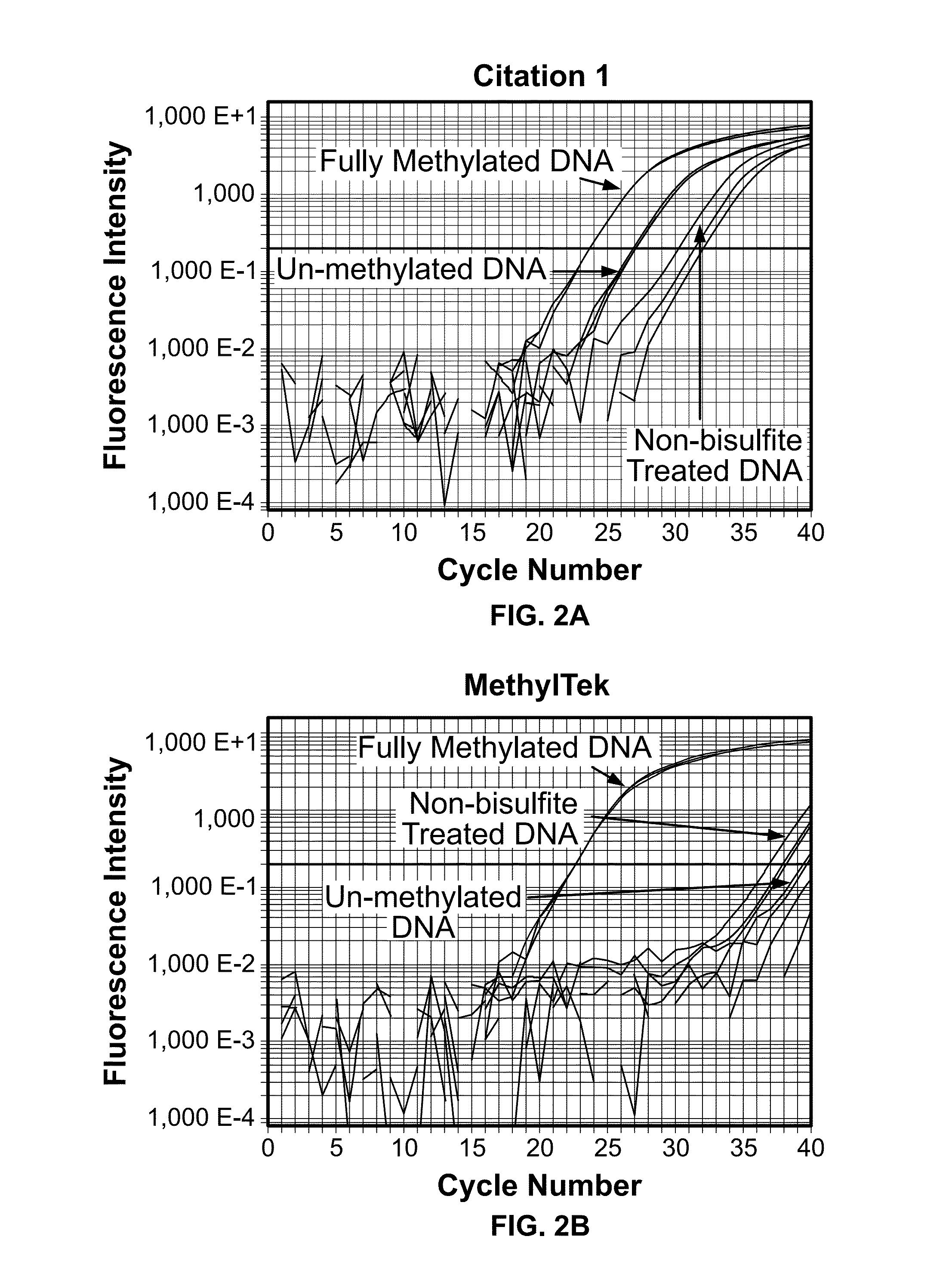Assays, methods and compositions for diagnosing cancer
a technology of cancer and composition, applied in the field of conditions, can solve the problems of loss of mmr protein expression, high microsatellite instability (msi-h), and no large patient cohort verification of these methods, and achieve the effect of high level of assay multiplexing and scalable automation
- Summary
- Abstract
- Description
- Claims
- Application Information
AI Technical Summary
Benefits of technology
Problems solved by technology
Method used
Image
Examples
example 1
Primers and Probe
[0032]Various embodiments are disclosed that enable the identification of reliable MLH1 methylation markers for the improved diagnosis and prediction of the susceptibility, diagnosis and staging of neoplastic disease, including CRC. To develop a reliable assay for accurately detecting MLH1 DNA methylation, a novel quantitative real-time system with primers and probe was designed for amplifying exclusively methylated MLH1 DNA. These primers and probe specifically target the region of the MLH1 promoter region critical for its expression, as identified in G. Deng et al. (1999). As discussed in detail below, the assay has been found to provide an accurate determination of MLH1 methylation status in CRC tissue.
[0033]Although several methods have been developed for MLH1 DNA methylation, these are mainly for research purposes and none of them has been successfully developed into an accepted standard assay for clinical molecular diagnostic use. A comprehensive study has ide...
example 2
Assay for Detecting MLH1 Methylation
[0039]The assay for detecting MLH1 DNA methylation combines amplification of MLH1 methylation and ACTB normalization control in a novel one-tube system. This design minimizes the amplification bias between MLH1 and the ACTB control due to variations from pipetting and amplification efficiency in different PCR reactions. The assay comprises the primers and 6-FAM / TAMRA probe for MLH1 methylation selected from those set forth in FIG. 4 (although other probes and primers may be further developed), as well as primers and probes for the ACTB control. The probes for detection of MLH1 methylation and the ACTB control are labeled with different reporter dyes—e.g., 6-FAM and HEX, respectively. However, any suitable reporters now known or hereafter developed is within the scope of the invention. Exemplary primers for the ACTB control are known in the art. For example, VIC / TAMRA labeled probes are commercially available from Applied Biosystems (ABI) and Life ...
example 3
Test Quantitation
[0041]The assay was tested for the ability to selectively detect methylated DNA. The assay was performed as described in Example 2, using the forward primer MLH1-qMSPJHF1 (Seq. ID No. 1), the reverse primer MLH1-qMSPJHR1&2 (Seq. ID No. 2), and the probe MLH1-qMSPJHP (Seq. ID No. 4), as shown in FIG. 4. In vitro methylated lymphocyte DNA was used as a positive control. Non-methylated or non-bisulfite treated lymphocyte DNA were used as negative controls.
[0042]The assay was found to be highly specific and sensitive in detecting MLH1 DNA methylation in comparison to the highly cited, prior art method of Bettstetter (2007) (FIG. 1). As shown in FIG. 2A, the method of Bettstetter (2007) had only 8-fold difference (3 cycles) in selectively detecting in vitro fully methylated DNA over non-methylated DNA. Moreover, this method was also found to nonspecifically amplify bisulfite unconverted DNA.
[0043]In contrast to the prior art methods, the present assay showed more than 10...
PUM
| Property | Measurement | Unit |
|---|---|---|
| fluorescence | aaaaa | aaaaa |
| fluorescence intensity | aaaaa | aaaaa |
| , real time PCR | aaaaa | aaaaa |
Abstract
Description
Claims
Application Information
 Login to View More
Login to View More - R&D
- Intellectual Property
- Life Sciences
- Materials
- Tech Scout
- Unparalleled Data Quality
- Higher Quality Content
- 60% Fewer Hallucinations
Browse by: Latest US Patents, China's latest patents, Technical Efficacy Thesaurus, Application Domain, Technology Topic, Popular Technical Reports.
© 2025 PatSnap. All rights reserved.Legal|Privacy policy|Modern Slavery Act Transparency Statement|Sitemap|About US| Contact US: help@patsnap.com



